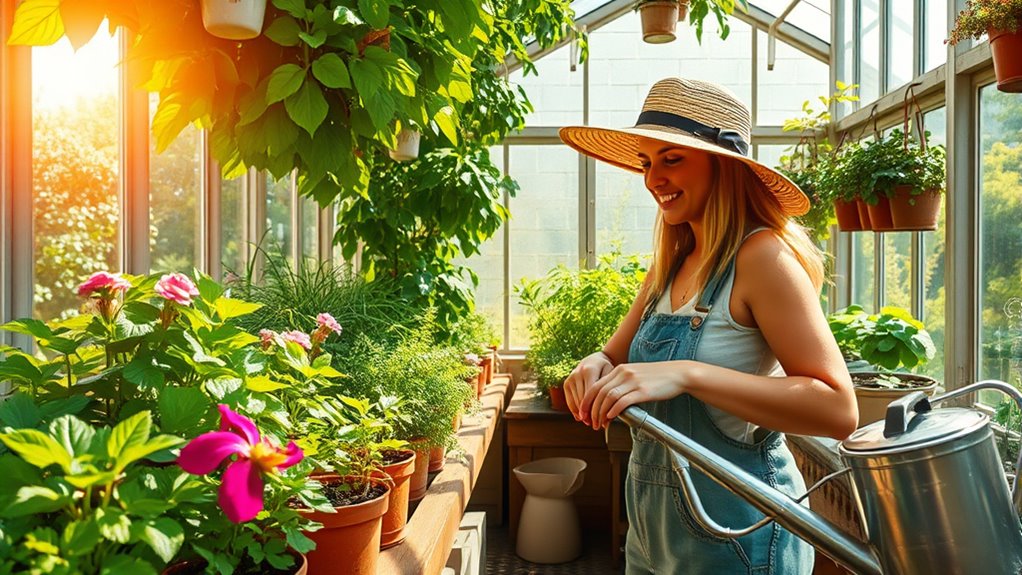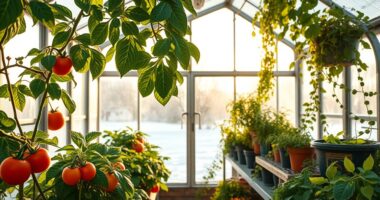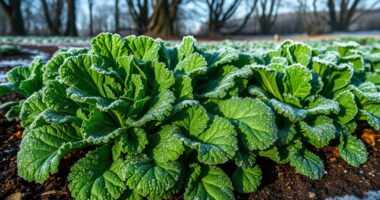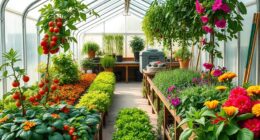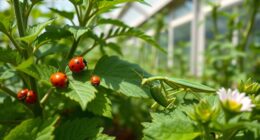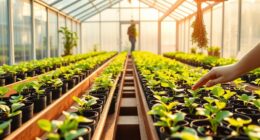To keep your summer greenhouse thriving, focus on effective temperature control and humidity management. Use natural ventilation and shading techniques to shield plants from heat stress. Implement efficient watering methods, like drip irrigation, to ensure consistent moisture. Regularly monitor for pests and diseases by practicing sanitation and introducing beneficial insects. By maintaining optimal conditions, you'll support healthy growth and vibrant plants. Discover more strategies to enhance your greenhouse management for a successful summer season.
Key Takeaways
- Implement effective temperature control strategies using natural ventilation, shading techniques, and automated systems to maintain an optimal greenhouse environment.
- Monitor and adjust humidity levels, aiming for 60-85% relative humidity to promote healthy plant growth and prevent diseases.
- Utilize efficient watering techniques, such as drip irrigation and soil moisture monitoring, to prevent overwatering and conserve water resources.
- Regularly inspect for pests and diseases, practicing sanitation and introducing beneficial insects to maintain plant health and reduce infestations.
- Choose summer crops that thrive in greenhouse conditions, ensuring consistent care for vibrant and productive growth during the season.
Effective Temperature Control Strategies
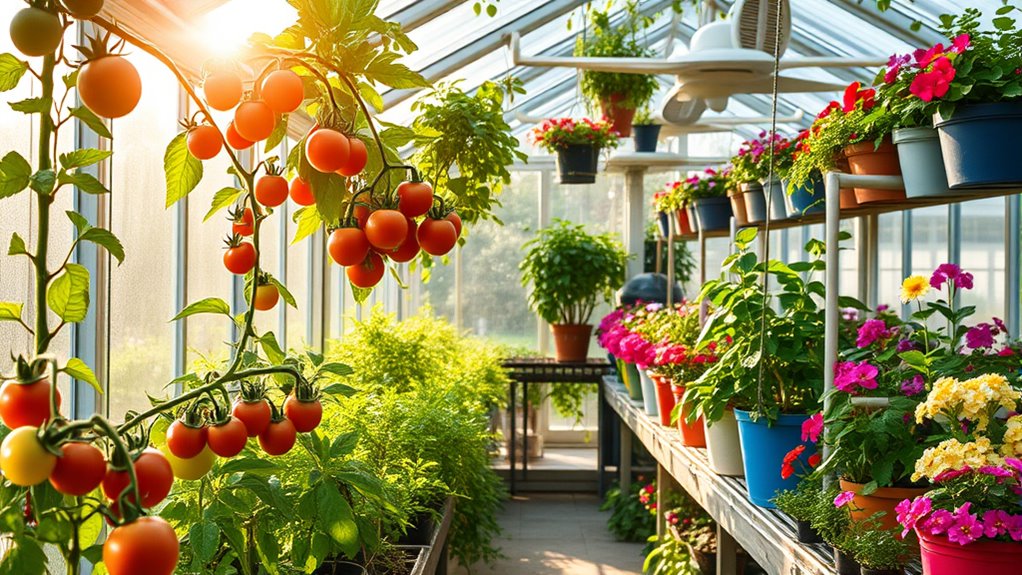
When summer heat hits, effective temperature control strategies become essential for maintaining a healthy greenhouse environment. You can start by utilizing natural ventilation through roof and side vents, which create drafts that pull out hot air while allowing cooler air to enter. If you prefer automation, consider installing sensors that automatically adjust vent openings based on temperature and humidity. Don't overlook the importance of shading; using shade cloth or strategically planted vines can significantly reduce heat. Implementing misting systems or evaporative cooling pads can also help cool your plants and prevent heat stress. Optimal humidity levels are also crucial during the summer months, so regularly monitor and adjust to ensure your greenhouse remains a thriving environment for your plants during those sweltering summer months.
Managing Humidity Levels for Optimal Growth
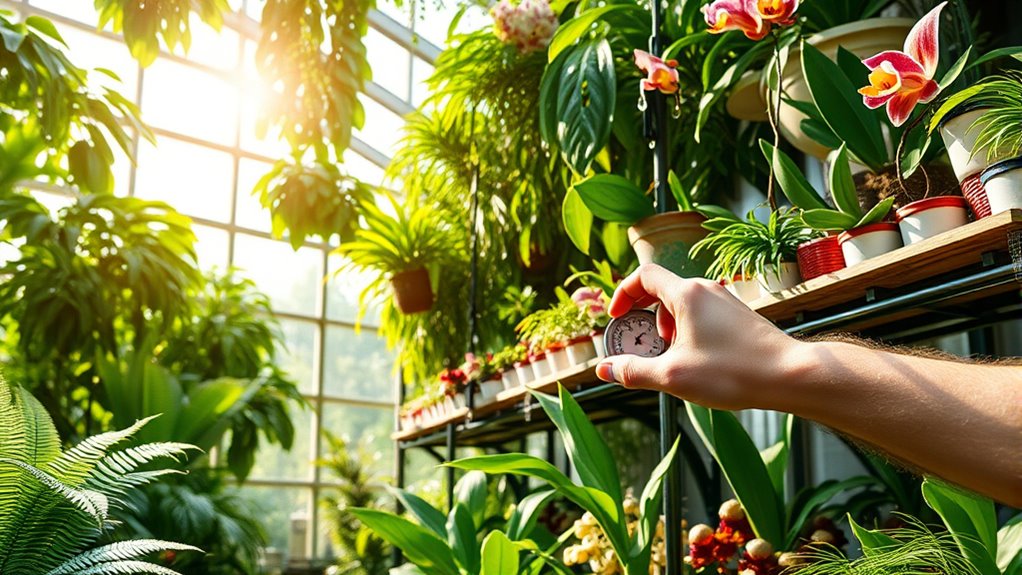
Maintaining the right humidity levels in your greenhouse plays a vital role in supporting plant growth, especially after implementing temperature control strategies. Humidity, which measures the amount of water vapor in the air, directly impacts your plants' transpiration and nutrient uptake. Aim for 60-85% relative humidity for most crops, adjusting as needed for specific plants.
To manage humidity effectively, utilize natural ventilation by opening vents or employing mechanical systems like fans. Regular air exchange helps maintain optimal levels, while dehumidifiers can be a great asset in high-humidity conditions. Additionally, cooling causes condensation, so it's essential to monitor temperature changes that can affect moisture levels.
Monitor humidity with humidistats and consider using vapor pressure deficit (VPD) for more precise control. By staying proactive, you can create the ideal environment for your plants to thrive.
Efficient Watering and Irrigation Techniques
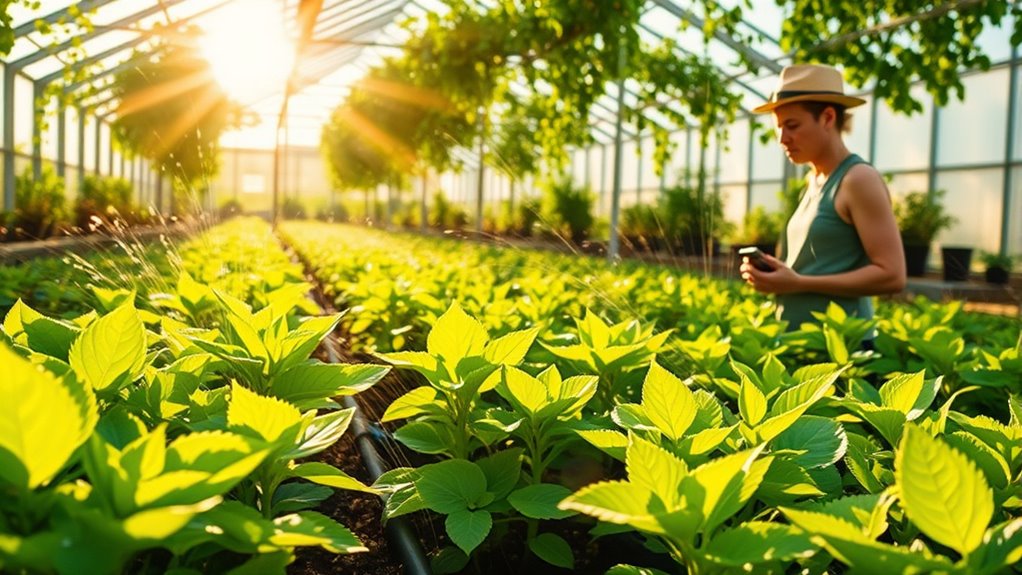
To ensure your plants thrive in the greenhouse, efficient watering and irrigation techniques are essential.
Water your plants early in the morning or evening to minimize evaporation and prevent leaf scorch. Always monitor soil moisture to avoid overwatering, which can lead to root rot. Well-watered plants can still wilt in extreme heat, so be proactive in your watering routine.
Group plants with similar watering needs to optimize water usage and create zones for tailored care. Consider using drip irrigation systems that deliver water directly to roots, conserving both water and nutrients.
If you prefer manual methods, warm water from a hose or watering can works well.
Lastly, don't forget to maintain your irrigation systems to prevent leaks and ensure efficiency. These practices will keep your plants healthy and flourishing all summer long.
Disease Prevention Methods for Healthy Plants
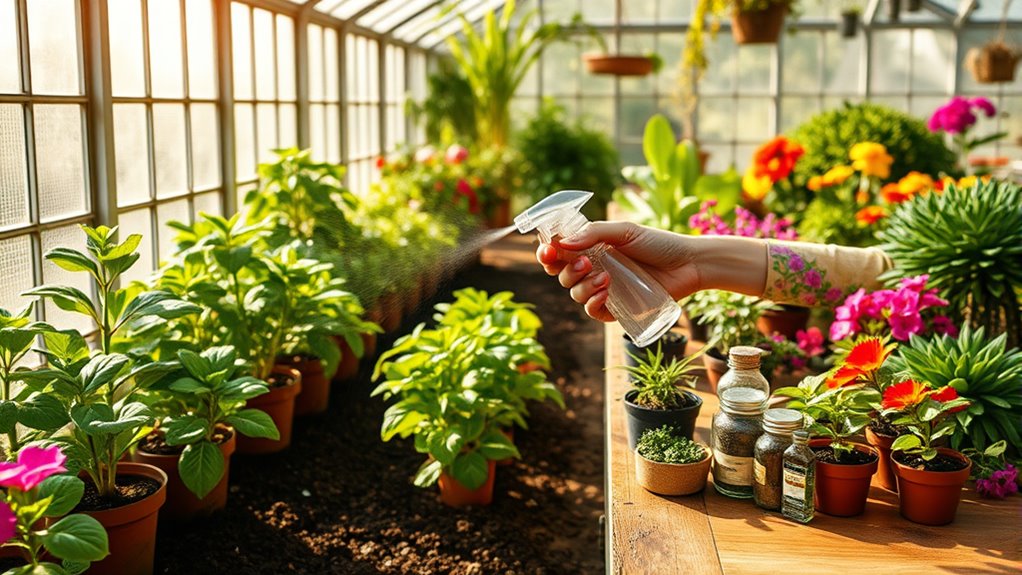
While ensuring your greenhouse thrives, implementing effective disease prevention methods is crucial for keeping your plants healthy.
Start by practicing regular sanitation; clean surfaces, tools, and equipment to prevent disease spread. Remove plant debris and weeds to minimize pathogen risks. Always use disease-free seeds and inspect new plant material before introduction. Additionally, consider using composting techniques to enhance soil health and reduce disease risks, as healthy soil plays a vital role in plant resilience.
Practice regular sanitation and inspect all new plant materials to prevent disease spread in your greenhouse.
Ensure proper ventilation and airflow to reduce humidity, which can cause fungal diseases. Keep temperatures optimal to avoid plant stress that makes them susceptible to illness. Regularly monitor temperature and humidity levels to adjust conditions promptly.
Regularly inspect your plants for early disease signs and isolate any infected ones immediately. Lastly, control access to your greenhouse and use footbaths to maintain cleanliness.
These methods will help you maintain a robust and healthy growing environment.
Integrated Pest Management Approaches
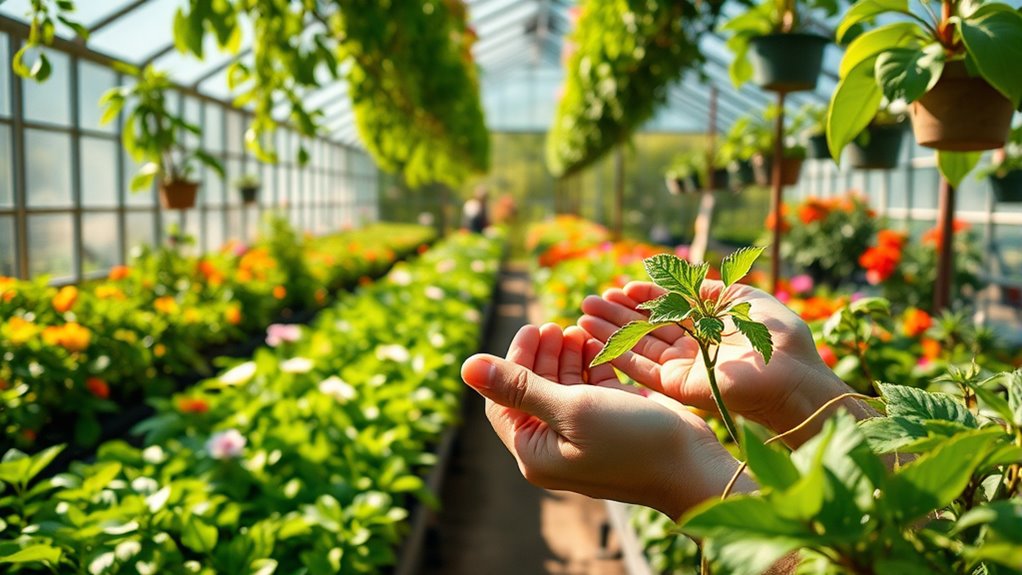
Integrated Pest Management (IPM) offers a comprehensive strategy for managing pests in your greenhouse, combining various tactics to keep crops healthy.
By using cultural controls like adjusting environmental conditions and maintaining sanitation, you can prevent pest-friendly environments. Cultural practices such as monitoring soil moisture and leaf wetness play a vital role in minimizing pest and disease conditions. Ensuring adequate space between plants can also reduce competition and promote healthier growth.
Introduce biological controls, such as beneficial insects, to naturally suppress pest populations.
While judiciously applying chemical controls, focus on reduced-risk pesticides that are compatible with the ecosystem.
Regular monitoring and record keeping are essential; scout weekly to catch pest issues early, identify them accurately, and determine economic thresholds for intervention.
This holistic approach not only enhances plant quality but also reduces your reliance on chemical pesticides, promoting a more sustainable and healthy greenhouse environment.
Essential Greenhouse Maintenance Practices
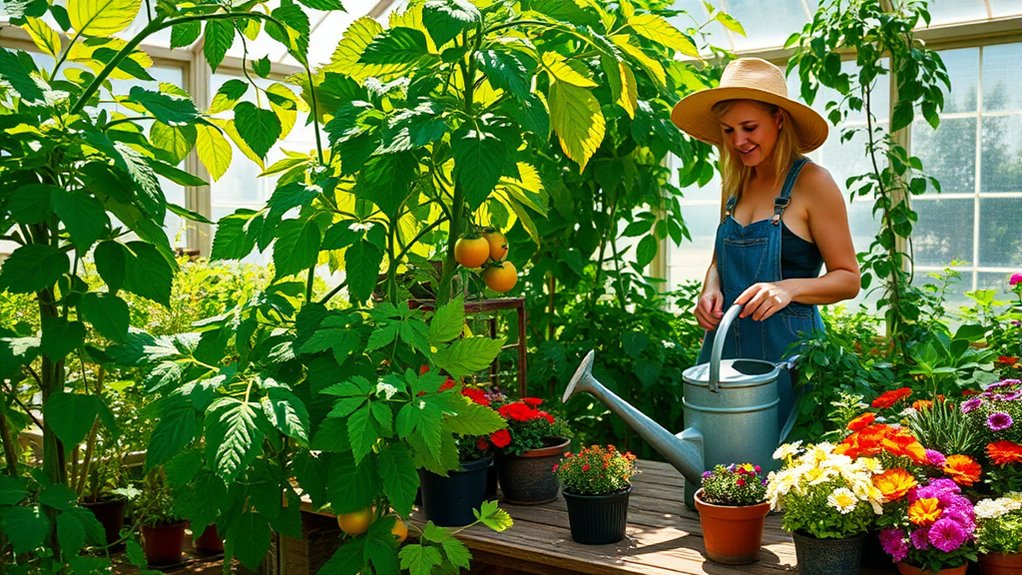
Maintaining a greenhouse is essential for promoting healthy plant growth and maximizing productivity. Start with regular cleaning—wash exterior panels at least twice a year with mild soap to ensure optimal light transmission.
Inside, remove plant debris frequently to prevent pests and diseases, and disinfect tools with bleach or eco-friendly options. At the end of each growing season, perform a deep clean to eliminate all plant matter. Regular cleaning and sanitation is crucial for maintaining a healthy environment for your plants.
Regularly clear plant debris and disinfect tools to ward off pests and diseases, ensuring a healthy greenhouse environment.
Don't forget ventilation! Keep systems dust-free and operational to avoid mold.
Monitor temperatures closely, maintaining a range of 65-75°F during the day. Lastly, inspect your equipment regularly for any issues, tighten frame components, and ensure all gutters are clear to prevent water damage.
These practices will keep your greenhouse thriving all summer long!
Selecting the Right Summer Plants
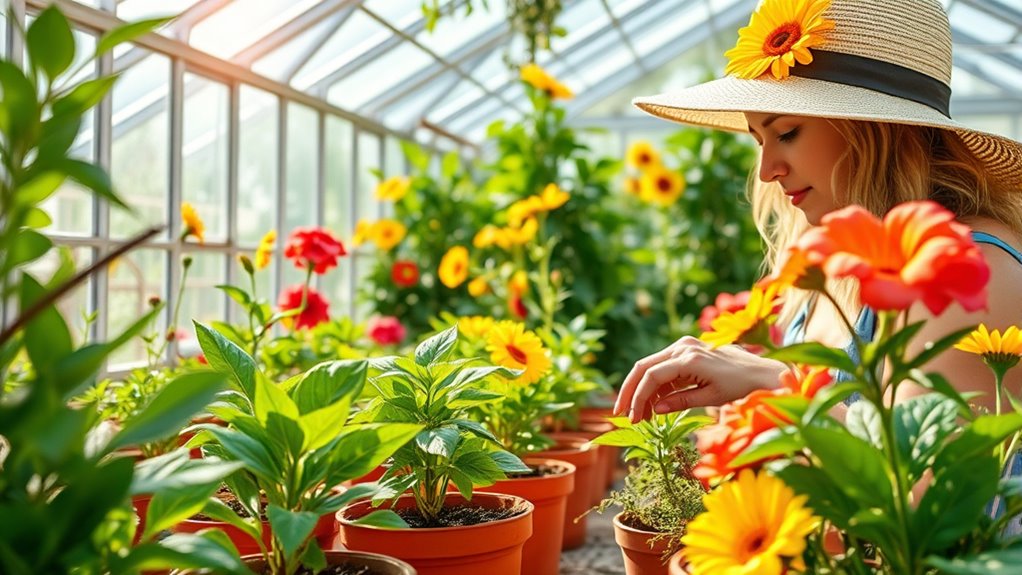
How do you choose the right plants for your summer greenhouse? Start by selecting heat-loving crops like tomatoes, peppers, and eggplants, which thrive in warm conditions. Varieties such as 'Sungold' and 'California Wonder' are excellent choices.
Don't forget about okra and melons, like cantaloupe, that love the heat. For herbs, basil and marjoram can flourish alongside your vegetables. If you want leafy greens, consider growing lettuce or romaine, as they mature quickly.
For fruiting plants, strawberries and cucumbers perform well in warm, humid environments. Consistent watering is essential for healthy growth in these plants. Lastly, adding a few ornamental options like hibiscus can enhance your greenhouse's ambiance.
With the right selection, you'll create a vibrant summer garden that thrives in your greenhouse.
Utilizing Shading Techniques for Heat Protection
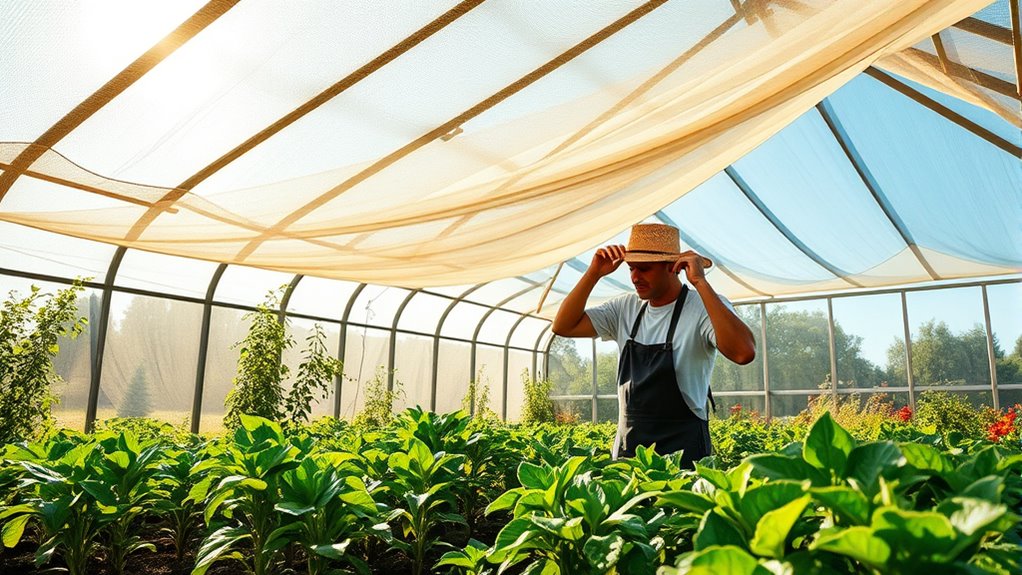
As summer heat intensifies, utilizing shading techniques becomes essential for protecting your greenhouse plants. Shading reduces temperatures by blocking or reflecting sunlight, preventing scorching and heat stress.
You can choose from various methods, including external shade netting, internal shade screens, and shade paint. Shade cloth is durable and effective year-round, available in different densities to suit your needs. Alternatively, shade paint is easy to apply and can be removed when not needed, all while preserving essential light for photosynthesis. By implementing these techniques, you can significantly cut energy costs associated with cooling systems. Additionally, using light color or aluminized materials can lower greenhouse temperatures by up to 30%, further enhancing your plants' growing conditions.
Regularly inspect and maintain your shading materials to ensure they remain effective throughout the season, optimizing your plants' growing conditions.
Implementing Monitoring Systems for Real-Time Management
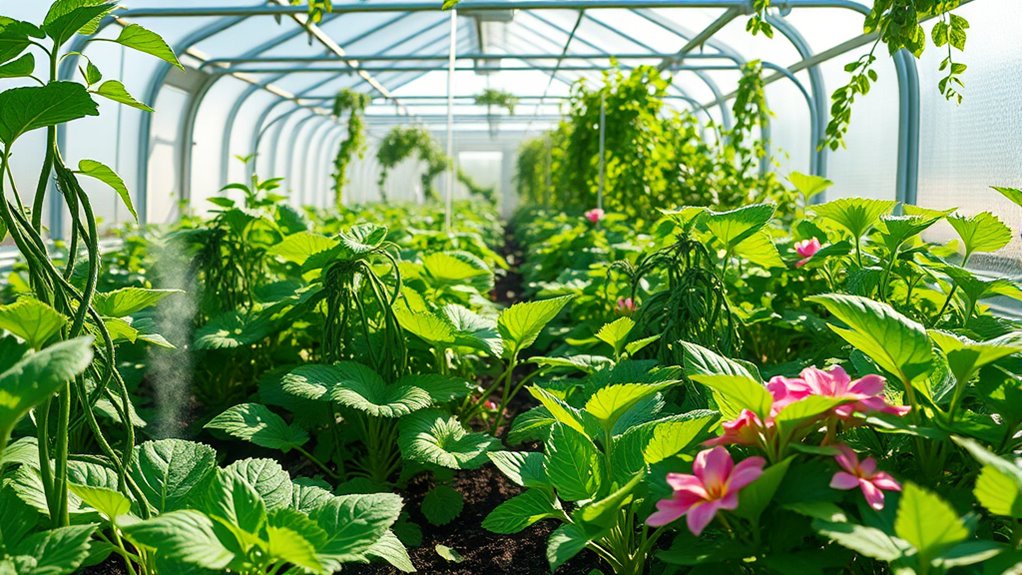
To ensure your greenhouse thrives during the summer heat, implementing monitoring systems for real-time management is crucial. IoT sensors provide continuous data on temperature, humidity, and light levels, allowing you to make immediate adjustments. They also monitor soil moisture, carbon dioxide, and nutrient concentrations to optimize growth. With wireless connectivity, you can access this data remotely via mobile apps, enhancing your control. Additionally, E-Control Systems utilizes wireless sensors to monitor your greenhouse environment effectively. Automated systems adjust ventilation, lighting, and irrigation based on real-time data, improving energy and water efficiency. By analyzing historical data, you can identify trends and make informed decisions about resource management. Plus, automated alerts keep you informed when conditions deviate from optimal ranges, ensuring prompt intervention to keep your plants healthy.
Frequently Asked Questions
How Can I Tell if My Greenhouse Is Too Hot?
You can tell your greenhouse is too hot by checking the temperature; if it exceeds 90°F (32°C), it's likely overheating.
Look for signs of plant stress, like wilting or scorched leaves. If the humidity feels excessive, that's another red flag.
Trust your instincts—if it feels uncomfortably warm for you, it's too warm for your plants.
Regularly inspecting air circulation also helps prevent overheating and keeps your plants healthier.
What Are the Signs of Overwatering My Plants?
You might think overwatering's hard to spot, but it's actually quite noticeable.
Look for yellow or brown leaves that feel limp instead of dry. If both new and old leaves are dropping, that's a red flag.
Check for mushy stems and grey, slimy roots, which indicate rot. Also, watch for a foul odor or fungus.
Regularly monitoring your plants helps you catch these signs early and avoid serious damage.
How Often Should I Inspect for Pests?
You should inspect for pests at least once a week.
Regular scouting helps you spot any issues early and keep them under control.
Focus on areas known for pest problems, and don't forget to check random plants to catch unexpected threats.
Keeping detailed records of your findings will improve your pest management over time.
As you gain experience, your inspection frequency and efficiency will naturally increase, making your efforts more effective.
Can I Use Regular Soil in My Greenhouse?
You can't use regular garden soil in your greenhouse. It's often too dense and can harbor soil-borne diseases.
Instead, opt for potting soil, which is lightweight and designed to drain well. This type of soil keeps your plants healthy and minimizes disease risk.
Additionally, consider mixing in organic matter like compost to boost fertility and structure.
Always check your soil for pH and nutrient levels to ensure optimal plant growth.
What Should I Do if My Plants Show Stunted Growth?
If your plants show stunted growth, start by checking environmental factors.
Ensure they're getting enough light and that temperatures are stable.
Assess soil moisture; both overwatering and underwatering can cause issues.
Test the soil pH and nutrient levels to identify deficiencies.
Also, look for signs of poor air circulation or mold.
Adjusting these elements can help your plants recover and thrive.
Don't forget to monitor regularly for any changes!
Conclusion
By applying these summer greenhouse care strategies, you can significantly boost your plants' health and productivity. Did you know that maintaining a stable temperature can increase plant growth rates by up to 30%? By focusing on effective temperature control, humidity management, and efficient watering techniques, you're not just preserving your plants; you're maximizing their potential. With the right practices in place, you'll watch your greenhouse thrive like never before this summer!
